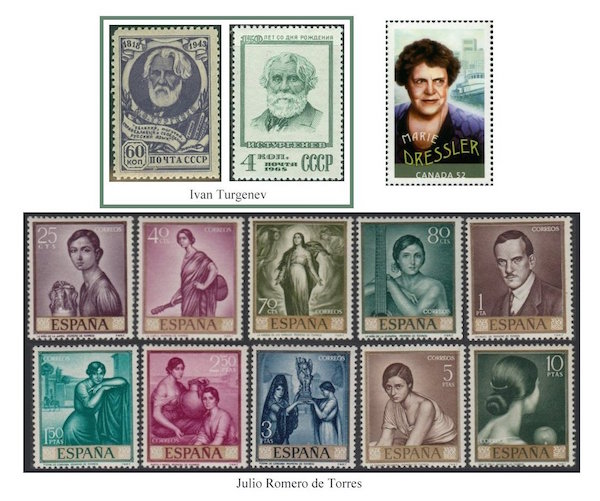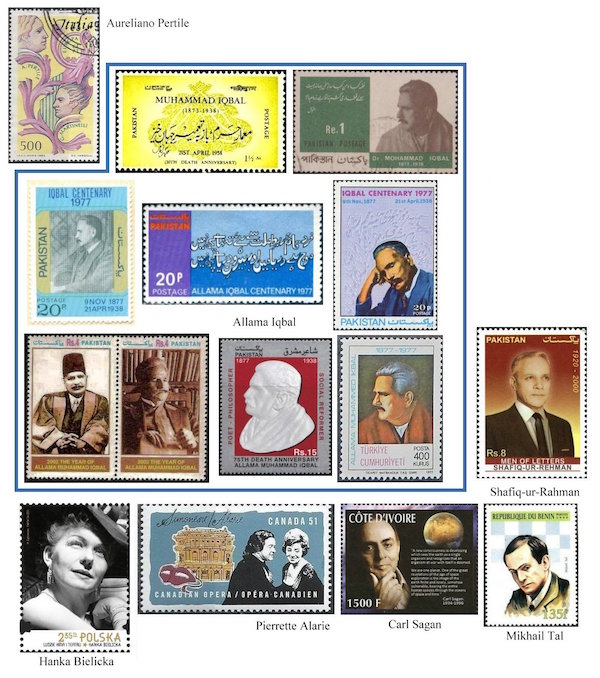The Arts on Stamps of the World — November 9
An Arts Fuse regular feature: the arts on stamps of the world.

By Doug Briscoe
On November 9 we salute Ivan Turgenev, Marie Dressler, and Carl Sagan (he wrote a novel, remember), along with Spanish painter Julio Romero, opera singers Aureliano Pertile and Pierrette Alarie, two important Pakistani writers, an actress from Poland, and Russian chess Grandmaster Mikhail Tal.
The author of Fathers and Sons, Ivan Turgenev (9 [O.S. October 28] 1818 – September 3, 1883) came of a noble family, one of his ancestors having been a convert from the Golden Horde, another having been awarded the family estate by Ivan the Terrible. Our Ivan studied at Moscow, St Petersburg, and Berlin. Exposure to the West made him more cosmopolitan and more secular in his tastes than such contemporaries as Dostoevsky. Much of his later life was lived in Baden-Baden and Paris. His lover for many years was the French opera singer Pauline Viardot. He counted Flaubert and Henry James among his dearest friends. (I remember reading Henri Troyat’s biography of Turgenev with dismay that there was not a single mention of James in the whole book.)
The wonderful Canadian-American actress Marie Dressler (November 9, 1868 – July 28, 1934) was born Leila Marie Koerber in Ontario. The family moved to Michigan, and Marie left home at age 14 to work for an itinerant theater troupe (she told them she was 18). After working for a company in Philadelphia, she relocated to Chicago and then New York and appeared on Broadway in 1892. She was able to form her own traveling troupe in 1900. Her introduction to the movies was in a couple of shorts, but she had the distinction of starring in the first full-length feature comedy ever made, a Mack Sennett picture called Tillie’s Punctured Romance (1914), with a then little known actor by the name of Charlie Chaplin. After a period of decline, she resumed her film career in 1927. A few years later she won the Academy Award for Best Actress for her part in Min and Bill (1930), with Wallace Beery. For me, the quintessential Marie Dressler moment occurs near the end of Dinner at Eight, when Jean Harlow’s dumb blonde character says, “I was reading a book the other day,” and Dressler staggers and reaches out to the wall to keep from falling over.

Spanish painter Julio Romero de Torres (November 9, 1874 – May 10, 1930) had a penchant for painting gorgeous young women, with The Alluring Girl (La chiquita piconera, 1930) being choicely representative. A detail of this work is shown on the 5-peseta denomination (next to last) in the set of ten Romero stamps issued by Spain in 1965. He was born in Córdoba and lived there or in Madrid for most of his life. His father, also a well-known painter, Rafael Romero Barros, was the founder, curator, and director of Córdoba’s Museum of Fine Arts. Young Julio started studying art at age 10. He came to be known for his symbolist style, but also painted in the realist and impressionist modes. He taught clothing design in the School of Fine Arts in Madrid from 1916. His self-portrait appears on the 1-peseta value as well as on the 1953 100-peseta Spanish banknote. The other paintings in the set include: 25 centavos, Girl with Jar (La niña de la jarra, 1928); 40 cts, The Song (La copla); 70 cts, Madonna of the Lanterns (Virgen de los Faroles, 1928); 80 cts, Girl with Guitar; 1.50 ptas, a panel from The Poem of Córdoba (1913); 2.50 ptas, Marta y María; 3 ptas, the central panel from The Poem of Córdoba; and 10 ptas, Viva el pelo (1928).
Aureliano Pertile (1885–1952) was born in Montagnana, Italy, where Giovanni Martinelli had been born just 18 days earlier. (They are shown together on this Italian 1985 centennial issue.) He made his debut in Flotow’s Martha in 1911 and appeared at La Scala in 1916. He sang Cavaradossi at the Met in 1921 and performed in six other operas there, but that was his only Met season. On his return to Italy he became one of the favorite singers of Arturo Toscanini. Pertile made recordings between 1922 and 1942, including three complete operas: Aïda (1928), Il trovatore (1930), and Carmen (in Italian, 1932). Besides his work in the standard repertoire, he also created roles in two operas by Argentine composers (!): Tucuman by Felipe Boero and Ollantay by Constantino Gaito.
Ignorant of Pakistani culture, I cannot tell whether the large number of stamps honoring
Allama Iqbal (November 9, 1877 – April 21, 1938) is due more to his statesmanship or to his poetry, as he seems to be revered for both. Called the “Spiritual Father of Pakistan”, he was a driving force, some say the leading force, behind the independence movement. On the other hand, his vast poetical output, thousands of verses, more than half in Persian, the rest mostly in Urdu, is held in the highest regard by those equipped, as I am not, to read it. Perhaps the fact that Wikipedia describes him as a poet first, then a philosopher, and then a politician, should give us a clue. That and the additional fact that he has been officially declared the “National Poet of Pakistan”. Widely known as Muhammad Iqbal, he published his first volume of Persian poetry in 1915, of Urdu poems in 1924. He also wrote in English, but not poetry, the central work being two volumes of philosophy. The earliest stamps, I believe, form a set of three issued on the twentieth anniversary of the poet’s death. I show one of these. There follow stamps from the years 1967, 1977 (x3), 2002 (a pair), and 2013. I also found another 1977 issue from Turkey.

Another prominent writer from Pakistan is a gentleman of an altogether different stripe: Shafiq-ur-Rahman (9 November 1920 – 19 March 2000). He was a humorist whose short stories and other works are also esteemed very highly. As a writer he has been likened to Mark Twain. Rahman began writing humorous stories at school and had a book published in 1938, before completing his medical studies. He did become a doctor and served in World War II with the Indian Army Medical Corps. After independence, he joined the Pakistan Army and eventually became a general. He was also chairman of the Academy of Letters of Pakistan from 1980 to 1985.
The Polish singer and actress Anna Weronika Bielicka (9 November 1915 – 9 March 2006) was affectionately known as Hanka Bielicka. She earned a post-graduate degree in philology and also attended the State Institute of Theater Arts in Warsaw. She first went on the stage in 1939, the year of her graduation. The first of her twenty movies was made in 1946, and in the next year she made a mark in cabaret. Bielicka recorded a CD at the age of 86, and her last film was released the year she died.
Canadian soprano Pierrette Alarie (November 9, 1921 – July 10, 2011) was married to the tenor Léopold Simoneau, with whom she appears on this 2006 stamp, one of a strip of five honoring Canadian opera stars. Pierrette Alarie’s parents were a choirmaster and a soprano. As a child she acted and sang popular music on the radio. She she went on a scholarship to the Curtis Institute to study with Elisabeth Schumann. Her Metropolitan Opera debut took place on December 8, 1945 (as Oscar in Un ballo in maschera under Bruno Walter), and she sang three seasons with the company. During that period she married Léopold Simoneau; the couple performed together many times.
What a loss to the world was the death at 62 of Carl Sagan (November 9, 1934 – December 20, 1996)! Of course, he was primarily an astronomer and astrophysicist who made great strides in popularizing science for Americans (one of the inspired was his splendid successor Neil deGrasse Tyson), but Sagan gets a spot on AoSofW as the author of a single novel, Contact (1985), made into a movie in 1997, a bit too late for Dr. Sagan to see it.
Time to recognize another great chess master. Today it’s Soviet Latvian player Mikhail Tal (Latvian: Mihails Tals; 9 November 1936 – 28 June 1992). He was champion of the world in 1960 and 1961. Those who may disagree with my including chess players on AoSotW may find Tal’s remark salutary: “Every game [is] as inimitable and invaluable as a poem.” Tal still holds the record for the longest (94 games) and second-longest (86) unbroken stretches of professional wins/draws.
Today’s honorable mentions are English film director Anthony Asquith (9 November 1902 – 20 February 1968), Pulitzer Prize-winning American poet Anne Sexton (November 9, 1928 – October 4, 1974), and the late Nobel Prize-winning Hungarian author Imre Kertész (9 November 1929 – 31 March 2016).
A graduate of the University of Massachusetts with a B.A. in English, Doug Briscoe worked in Boston classical music radio, at WCRB, WGBH, and WBUR, for about 25 years, beginning in 1977. He has the curious distinction of having succeeded Robert J. Lurtsema twice, first as host of WGBH’s weekday morning classical music program in 1993, then as host of the weekend program when Robert J.’s health failed in 2000. Doug also wrote liner notes for several of the late Gunther Schuller’s GM Recordings releases as well as program notes for the Boston Classical Orchestra. For the past few years he’s been posting a Facebook “blog” of classical music on stamps of the world, which has now been expanded to encompass all the arts for The Arts Fuse.
